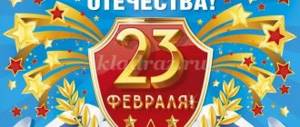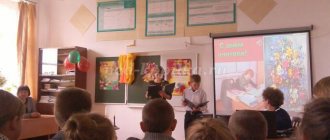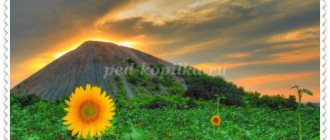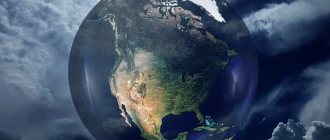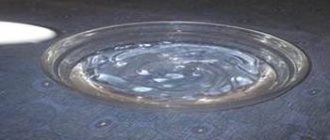Extracurricular activity for Earth Day in elementary school, grades 3-4
Scenario for environmental education “Save our planet!”
for grades 3-4. Author: Shelyagina Anna Vyacheslavovna, teacher-organizer of the MBU DO “Station of Young Naturalists” Abstract:
The event is dedicated to the most important environmental date - World Earth Day - and is held as part of the annual event “Days of Protection from Environmental Hazards”.
For the event “Save our planet!” An unconventional form of environmental education has been chosen to significantly expand and enhance children’s knowledge about the harmful effects of municipal solid waste on the environment, biological species listed in the Red Book of the Kemerovo Region, as well as to develop the creative activity of schoolchildren in solving environmental problems. Goal:
to promote the formation of an environmental culture of the younger generation by drawing attention to current problems of environmental conservation.
Progress of the event:
Presenter:
Hello, dear children and respected teachers!
Today we have gathered in this room to talk about our common home with you - planet Earth and how to keep it as beautiful, amazing and rich for many centuries. On April 22, we celebrate not just a big, but a truly global holiday - International Mother Earth Day, held under the auspices of the UN. The tradition of celebrating Earth Day on April 22 originated in the United States in 1970; in 1990, this day became an international event. It has been celebrated in Russia since 1992. In the Northern Hemisphere, Earth Day is celebrated in the spring, while in the Southern Hemisphere it is celebrated in the fall. The main goal of this worldwide action is to attract the attention of society and every person on the planet to the problems of the Earth, to the problems of its environment. Every year, scientists from around the world gather on this day at a round table to discuss global environmental problems. A wide variety of events and promotions are organized in different countries. These include conferences, exhibitions, closing traffic on the busy streets of large cities, cleaning the area and planting trees. In Russia, International Earth Day is traditionally considered the day of public organizations that hold various environmental events and campaigns on this day. On this day, everyone can take part in the improvement and landscaping of their yards and streets. What kind of our Earth is it, what amazing things our planet hides, what kind of neighbors surround our house - let’s try to remember by answering the questions of the “Warm-up”. 1. Warm up.
1. The time of day when the earth's surface gives off more energy than it receives?
(night) 2. Name the star closest to us? (Sun) 3. Which continent has no rivers? (Antarctica) 4. Is the Earth a planet or a star? (planet) 5. Who do they say stopped the Sun and moved the Earth? (Nicholas Copernicus) 6. Natural satellite of the Earth? (Moon) 7. The source of life on Earth? (Sun). 8. What shape is our Earth? (spherical, a ball, flattened on the sides) 9. What is more on the globe - land or water? 10.What is the name of the model of the Earth? (globe) 11. An imaginary line that divides the globe into two hemispheres (equator) 12. The structure of the earth’s surface, that is, mountains, lowlands, hills, etc. (relief) 13. The galaxy in which our planet is located (Milky path) 14. Molten mass of rocks located in the bowels of the Earth (magma) Well done guys, you know a lot about the Earth, space and the features of our planet. Now let's get to know your teams. 2. Presentation of commands.
Thank you, friends, for the interesting, creative and informative team presentations! The future of our native planet lies with you, the younger generation, and what it will be like in decades depends on each of us. After all, today our fragile living planet is in danger! It is threatened by many environmental problems and almost always their cause is man’s unreasonable consumer attitude towards nature. Pollution of the planet with garbage has become one of the global environmental problems today. Every year, humanity produces almost one and a half billion tons of household waste. According to a report from the Washington Institute, by 2025 this volume will at least double. The largest amount of waste occurs in economically developed countries, and the absolute leader is the United States. According to some calculations, each inhabitant of the Earth “produces” about 300 kilograms of garbage annually: in the USA - about 600, in Moscow - up to 360. So much garbage has accumulated on Earth that if it is not recycled, but leveled over the land surface of our planet, it will will cover the entire planet with a 3-meter layer! An exceptional example of ocean pollution is the existence of the Eastern Garbage Continent in the Pacific Ocean, located between the coast of California and Hawaii. Over the past 50 years, ocean currents have brought there at least 3.5 million tons of floating household waste, and the area of the ocean dump area exceeds the size of a state like Belarus! The existence of the garbage island is the cause of the death of millions of living beings!
What is garbage made of, guys?
Let's find out in the next task. You should use the description to find out what type of household waste we are talking about. Each description gives five characteristics of solid waste, if you guess the encrypted word by the first sign, you get the maximum number of points - 5, if by two - 4, etc. 3. Quiz questions “What is garbage made of”
1. The Chinese invented it.
2.It is obtained from wood. 3.It burns well. 4. This produces a lot of garbage. 5. People usually draw and write on this. (PAPER) 1.It is made from sand. 2.If you heat it up, it becomes sticky like dough. 3.If left in the sun, it may become a fire hazard. 4. Most often it is transparent. 5.When it falls, it breaks. (GLASS) 1.In the past, people used wet sand, clay, or a mixture of animal fat with water and wood ash instead. 2.It kills fish in the water and plants on the land. 3.We all use this every day. 4.With this, things and objects become cleaner. 5.When this gets into the water, it creates a lot of foam. (DETERGENTS) 1.This was invented in England in the mid-19th century. 2.It is produced from oil and natural gas. 3.It makes up most of the trash on Earth. 4.It hardly decomposes in nature. 5.This is often used to make food packaging. (PLASTIC) 1.It has been mined on the surface or in the depths of the earth since ancient times. 2.It is quite strong, it shines and most often bends. 3. It can be light, heavy and even noble. 4.It can often oxidize or rust. 5. A lot of things are made from this: building frames, tools, decorations, food containers, etc. (METAL) 1. These wastes appeared the very first, at the dawn of humanity. 2.They take up most of the trash can. 3.They can be of animal or plant origin. 4.Some of them can be used as fertilizers. 5.It decomposes quickly in nature. (FOOD WASTE, ORGANIC WASTE) 1.It is made of plastic and gas so it is very light. 2.It is used for heat and sound insulation. 3.It is highly flammable and when it burns it produces very toxic smoke. 4.It consists of grains and is most often white. 5.Various goods (especially fragile ones), household appliances and food products are packaged in this. (FOAM) In addition to the problem of solid household waste, one of the most pressing environmental problems remains the extinction of biological species. About three species of flora and fauna disappear every hour on Earth. This conclusion was reached by specialists from the Iberoamerican Center for Biological Diversity. Not since the death of the dinosaurs 65 million years ago have species on Earth been destroyed at such a rapid rate as in recent decades. From 1970 to 2000, the number of wildlife species declined by 40%. According to the Red Book, over the past 500 years, the extinction of 844 animal and plant species has been recorded. 4. Types of the Red Book of the Kemerovo region.
1. A perennial herbaceous plant, over 1 m high, with numerous erect stems that end in a beautiful large flower with five petals. It grows mainly in the Northern Hemisphere, often found in Siberia. It has various healing properties: it is used in the treatment of gout, rheumatism, various gastrointestinal diseases, bleeding, diseases of the nervous system, etc. The plant is popularly called Maryin root, Marya Korevna, zhgun-root. (PION EVADERING)
2. This is one of the very beautiful spring plants, with quite large lush golden flowers, which blooms at the end of April and blooms until the end of May. A beautiful legend about this plant is repeatedly mentioned in literature: the ancient Greek goddess of love Aphrodite fell in love with a beautiful young man and often wandered through the forests with him. One day he went hunting alone and died from the tusks of a wild boar. The goddess bitterly mourned her lover, and then turned him into a flower, sprinkling the young man’s blood with nectar. According to another legend, the flower got its name in honor of the Phoenician and Assyrian sun god, who died annually in the fall and was resurrected in the spring. People call it adonis, the more ancient name is starodubka, montenegorka, which indicates that the plant lives on the slopes of hillocks, well warmed by the sun. Preparations from the plant are used in the treatment of the heart and blood vessels and have a calming effect. (ADONIS SPRING).
3. A tall, beautiful tree with a spreading crown and heart-shaped leaves, an excellent honey plant.
In our region it is a relict species, since the islands of these trees in mixed forests are about several million years old. Not far from our city you can find a grove with this tree, unusual for our forests, preserved from the pre-glacial period! People call this wonderful tree black-trunked birch. The leaves and flowers of the plant have medicinal value as a means to strengthen the immune system, as well as a cosmetic product. (SIBERIAN LINDEN) 4. This is a large freshwater river and lake fish, up to 2 meters in length, living in the river basins of Siberia. The appearance of the fish is very characteristic: along the back, sides and belly there are rows of hard protrusions - bugs, the body between them is covered with star-shaped plates. Fish overwinter in river holes 20-30 meters deep, and in the spring they migrate to spawning grounds under the ice. The fish feeds on bottom invertebrates - aquatic larvae, worms, mollusks. Until the 1930s, it was one of the common fish in our rivers and served as an important fishery. The number of this fish has sharply decreased due to river pollution and poaching. (SIBERIAN STurgeon) 5. Non-venomous snake, most often no more than a meter in size. It differs from other snakes in its “yellow ears” - pronounced markings on the head, often yellow, but sometimes white and orange. It feeds mainly on live frogs, rodents, and less often fish. It is well tamed and tolerates captivity: in Ukraine and Belarus, there are frequent cases of domestication of reptiles for the destruction of mice. Due to catching by tourists, fishermen, vacationers, as well as disturbance and pollution of habitats, it is a rare species (COMMON) 6. Large feathered night hunter with a wingspan of 160 to 188 cm. Easily identified by its size, dark beak, paws with hair down to the claws and feathery ears tilted outward. A mysterious bird that avoids human proximity, which can be found in the taiga, forest-tundra, steppes and desert. It easily adapts to both northern frosts and the hot desert climate. The bird is sometimes classified as a pest due to the decline in hunting resources. But these ideas are easily refuted by the fact that these predators do not eat so much - no more than half a kilogram of meat per day, but their benefits for agriculture as rodent exterminators are invaluable (Eagle owl) 7. A small artiodactyl animal, body length up to 1 m, weight – 11-18 kg. The Latin name of the species translates as “bearing musk.” On the belly of a male animal there is a musk gland filled with a special secretion - musk - the most expensive product of animal origin. Another distinctive feature of the males of this peaceful herbivorous animal is the presence of long curved fangs protruding from under the upper lip by 7-9 cm and acting as a tournament weapon. Because of the musk, this animal is the object of hunting, and therefore needs special protection (musk deer) Due to unreasonable human activity, our planet is in danger: this is not only the problem of solid waste and the disappearance of biological species, but also the depletion and destruction of natural resources - forests , water, etc. However, every person can do a lot to ensure that our planet remains alive, rich, unique and beautiful. After all, for this you should follow the simplest rules of behavior in nature. Of course, you all know what these rules are. But in addition to observing these rules, you, the younger generation, can encourage others to follow them! Our latest competition is called “Save the planet for many years to come!” Each team is asked to take a picture depicting a rule of behavior in nature, and come up with a bright, memorable slogan that reveals this rule. 5.Slogan competition “Let’s save the planet for many years to come!” SLOGAN is an advertising formula, a constant advertising motto. A clear, clear and concise formulation of the main topic of the appeal. A slogan is a key phrase that identifies either a specific organization or a promotion carried out by it. Translated from English, slogan is a slogan, appeal or motto. For example: Remember and know your duty as a person, Don’t allow garbage in nature! A clean forest is the conscience of a tourist. A small spark is a big problem. Put out the fire! Take care of other people's ears - just listen to the singing of birds in the forest! Thank you guys for the creative slogans! If you publish them and encourage your parents, friends, and classmates to follow them, perhaps many of them will listen and take another step toward preserving our common home! We have one Earth.
We have one Earth, one, It is so blue. She calls us for help, so unprotected... If you don’t respond, at that very moment She will accuse us: “We didn’t protect, we didn’t save!” Save your Earth, people! Flowers bloom on it alone, Children laugh on it alone, And there is no more beautiful beauty, And there are no doves on the planet. She gave us joy, gave us dew and sunrises, and in all the worlds you cannot find a more beautiful mother planet. (D. Zevina)
Summing up and rewarding teams.
We recommend watching:
Extracurricular event on ecology for grade 3. Ecological travel quiz for grades 3-4 for Water Day. Extracurricular event on ecology for grades 2-5. Ecological excursion Game - a trip to the stations for 4th grade students on Earth Day
Similar articles:
Ecological class hour in grades 3 - 4
Class hour "Forest Giants", 3rd grade
Educational conversation in elementary school. Water and its properties
Game "Field of Miracles" for elementary school, grades 3-4. Undersea world
Poem about the earth for children, grades 2-4
history of the holiday
The tradition of celebrating Mother Earth Day originated in the United States on the initiative of environmental activist Gaylord Nelson. The holiday was first celebrated on April 22, 1970, and more than 20 million Americans took part in various events. Even the US Senate decided not to hold meetings on this day so that senators could take part in the holiday.
Question answer
What is International Earth Day?
In 1995, for his contributions to the tradition of celebrating this Day, Gaylord Nelson was awarded the Medal of Freedom, the highest honor that can be awarded to a civilian in the United States.
The organizers of the first Earth Day subsequently founded the international non-governmental organization Earth Day Network, which now works with more than 50 thousand partners from 196 countries. The Earth Day Network aims to develop environmental education for its events.
Today Mother Earth Day is celebrated in many countries. It has been celebrated in Russia since 1992. Moreover, every year this Day is dedicated to a specific topic. The theme of the Day 2020 is “Trees for the Planet”.
